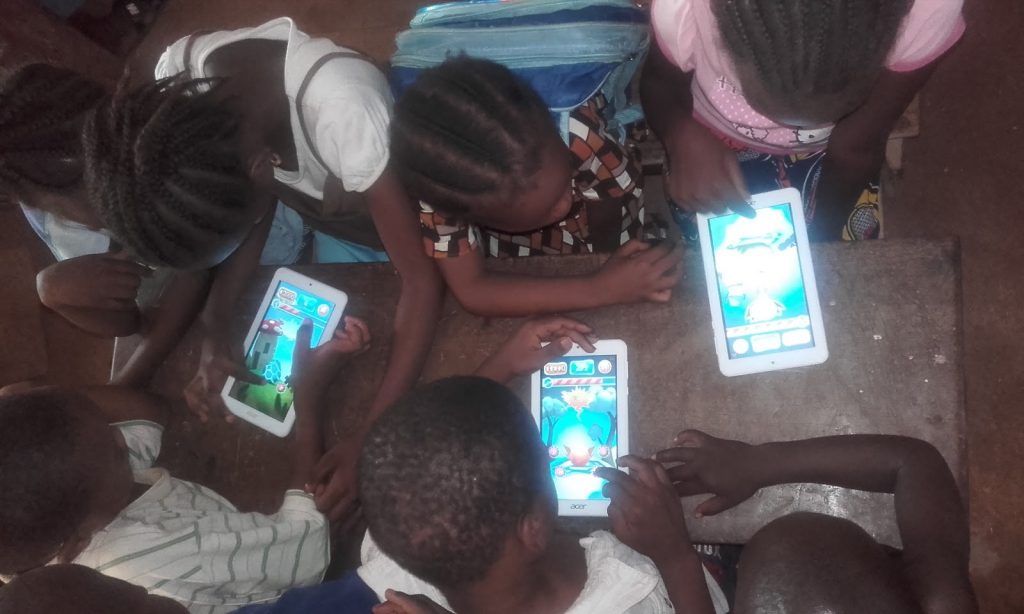Can Children Teach Themselves? We Think So
The 60 million girls Foundation has designed a new and innovative learning tool to give children the chance to teach themselves the basic skills they aren’t learning in the classroom. Our Mobile Learning Lab puts learning directly in the hands of children. This has led to impressive results in academic subjects and also in non-cognitive skills like aspiration, participation and confidence. Our experiences in the field confirm this intuition.
Why, you may ask, would we want children to teach themselves? What about the teachers? The short answer is the global learning crisis. While barriers like poverty, early marriage, conflict and disability are keeping 262 million children out of school, even children who are in school are not learning. Data show that 617 million children globally do not meet minimum proficiency requirements for their grade level in reading and math.
New assessments confirm these findings and point out that the vast majority of children not learning live in developing countries. And there is a worrying asymmetry because while 20% of children in developed countries are not hitting basic learning benchmarks, in low-income countries only 20% of children are reaching these minimum standards. There is something fundamentally wrong and unfair with this picture.
When we talk about self-directed learning we’re not suggesting that teachers are unimportant. In fact, we think that quality teaching is the most important component of an effective learning environment.
But the problem is that there are just too many children for the number of trained teachers available. This is particularly true in sub-Saharan Africa where population growth, combined with increased demand for schooling, means that classrooms are overcrowded.
The UNESCO Institute of Statistics estimates that we’ll need 69 million teachers globally by 2030 to achieve quality education. It will take years to develop this human capital and in the meantime, millions of children are out of luck.
Self-directed learning can bridge the gap
The evidence shows that self-directed learning can have a significant impact on a range of skills. Sugata Mitra’s hole in the wall project in India was a first indication that vulnerable children could teach themselves. So based on this and other research – including our own intensive inquiries and pilot projects – the 60 million girls Foundation designed and launched the Mobile Learning Lab (MLL).
Technically, the MLL is made up of a RACHEL-Plus, which acts a server for up to 50 devices, like a tablet or large-screened mobile phone, and can be charged by solar panels if no electricity is available. The largest RACHEL model has 1 terabyte of storage so children can have access to multiple sources of content offline, with no need for Internet connectivity.
The MLL content includes KA Lite (Khan Academy) for math and science, Fantastic Phonics and Feed the Monster for literacy, e-books and many other sources of educational resources, all of which can be curated to fit any local context.
Making learning fun is important
Last year, we ran an after-school pilot project for students in grades 4, 5 and 6 in five rural communities in northern Sierra Leone. We gave tablets to 682 students and told them they could do whatever they wanted with them – putting the learning tools, literally, in their hands.
The first important take-away was that the children loved the MLL. With no adult direction, they were able to turn on the tablets, find the cameras and take pictures of each other. At first glance, this may not seem educational, yet, the children tended to work in groups, building self-confidence among their peers, and experimenting with each app over several sessions.
Over time, they focused on the learning tools they liked best, either to explore subjects of interest to them, or to get extra practice on topics already discussed in class but needed extra help to master. They had no (or little) instruction from the MLL coordinator. All learning was self-directed.
Based on testing before and after the introduction of the MLL, the students posted impressive academic gains and, for the children who had access to the MLL for 120 hours, test scores in math and literacy almost doubled. The increase in literacy was particularly significant. We attributed this not only to the use of literacy apps but the fact that students were not directed towards any particular subject and all apps and software are in English. And, even with only partial use of the MLL (32 hours), literacy results increased compared to the control group.
Our non-cognitive skills questionnaire – given to children before and after exposure to the MLL – asked about life goals, what they liked about school and whether they enjoyed working with their peer group. The answers either showed increases in skill acquisition or stayed at around the same level as the baseline.
An added bonus is that it is sustainable. Once the project ended the communities continued to use the MLL and, in fact, increased children’s access to it by as much as five additional hours per week, despite the end of the funding.
The global learning crisis clearly shows that the status quo is not an option. To get all children learning, and to reach the most vulnerable who have little access to school, trained teachers or even textbooks, we believe that an innovative solution is required. The MLL hits all the right buttons and, most importantly, it puts learning directly in the hands of children. That is a solution that we can get behind.

